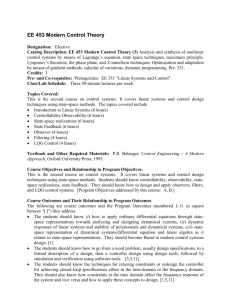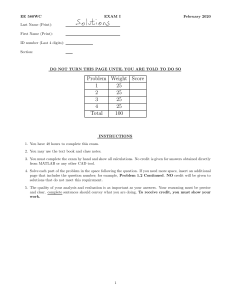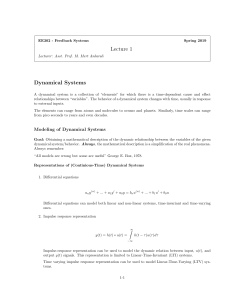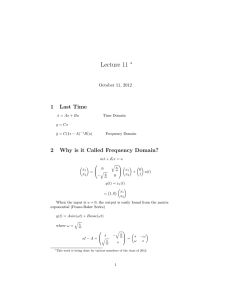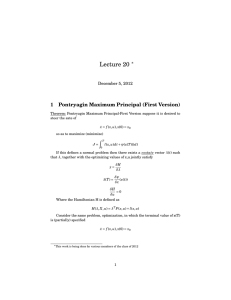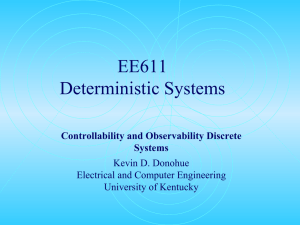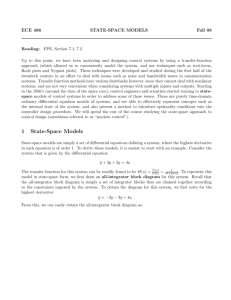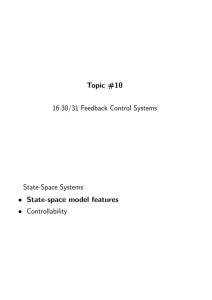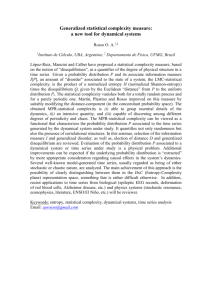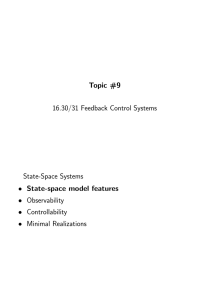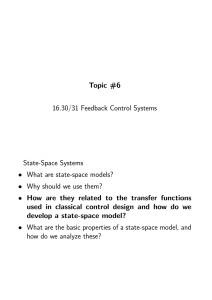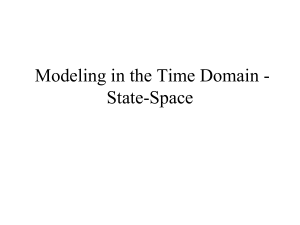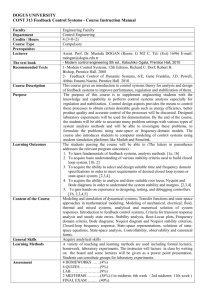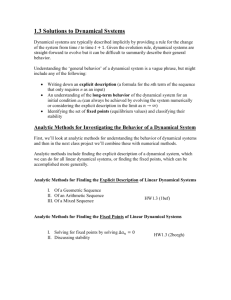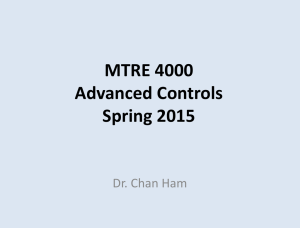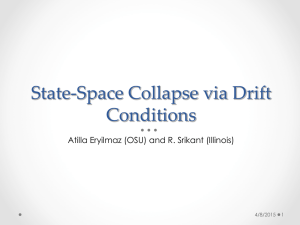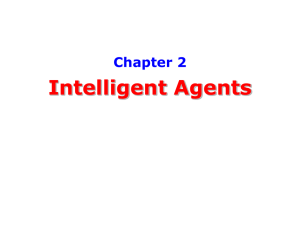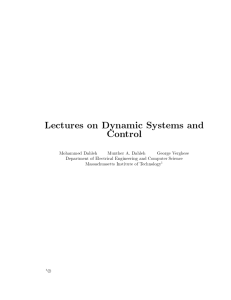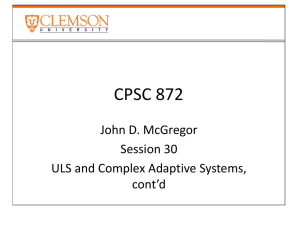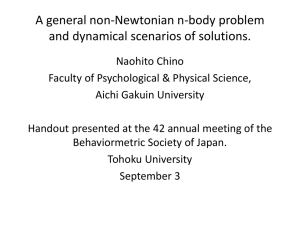Linear Systems Theory (239085) ******
advertisement
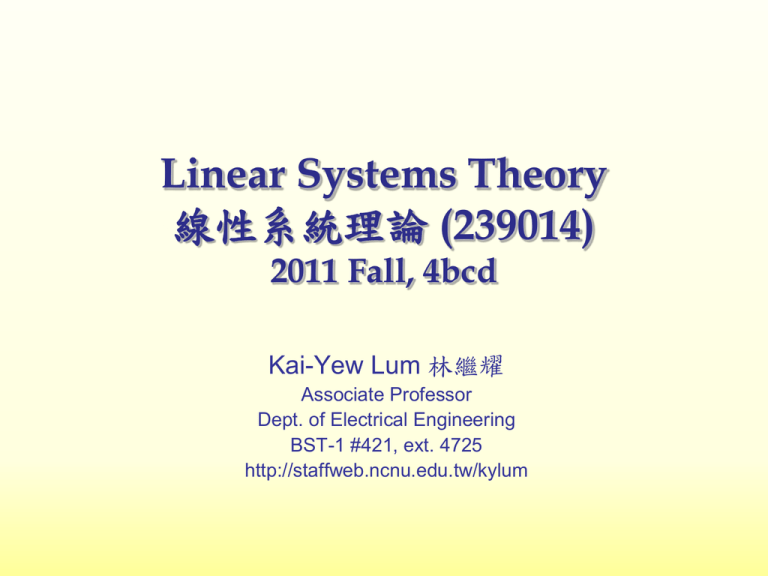
Linear Systems Theory 線性系統理論 (239014) 2011 Fall, 4bcd Kai-Yew Lum 林繼耀 Associate Professor Dept. of Electrical Engineering BST-1 #421, ext. 4725 http://staffweb.ncnu.edu.tw/kylum Objectives • Motivation – Linear Systems Theory is the foundation of systems, control and signal processing. – Past development of this discipline has produced a mature and fairly complete set of concepts and methods – These are fundamental knowledge in electrical engineering, communications, mechanical engineering, medical engineering, etc. • Course Objectives – Explore the basic theory of linear systems and its applications. – Provide the necessary tools for engineering problems: • mathematical description • analysis (especially numerical analysis) Time Line of Systems Theory in Control Engineering 1950’s Linear Systems Theory Ziegler-Nicholas LQR LQG 1960’s 1970’s Kalman filter Transfer matrix Lyapunov Theory Matrixfraction description Adaptive Control LQG/LTR Sliding Mode 1980’s H∞ -Synthesis 1990’s 2000’s Dynamic Inversion Adaptive Back-Stepping Classical & frequency domain techniques State-space techniques Nonlinear techniques MPC Lesson Plan I. Introduction II. Mathemetical Description of Dynamical Systems III. Review of Linear Algebra -- Matrix Theory IV. State-Space Solution V. Controllability & Observability, Stability VI. Transfer Matrix Description and Realization VII. State Feedback and State Estimators VIII. Introduction to Linear Sampled-Data Systems What You Should Expect to Learn • Mathematical Description of Dynamical Systems – When we study a dynamical system, i.e. a system that evolves in time with memory effects, we need to describe (represent) its behavior in equations in order to conduct meaningful analysis and computation. – You should also learn the key characteristics that make a system “linear”, the concept of “state”, and the correspondence between the state-space representation and what you already know in frequency domain description (transfer functions). What You Should Expect to Learn • Review of Linear Algebra – – – – Matrix notations Properties: determinant, rank, eigenvalues Characteristic polynomial; Cayley-Hamilton theorem Special matrices: • Definite matrices • Orthogonal matrices • Singular values & SV decomposition (SVD) • Transformation & diagonalization – Generalized eigenvalues & Jordan blocks What You Should Expect to Learn • State-Space Solution – The solution of a dynamical system is its “trajectory” from an initial state, either on its own or under influence of an external input. – The solution of a linear system is structured and easy to understand if you think of it as linear combination of some “template” solutions: a basis of solutions. – Though there is an infinite number of solutions, the dimension of this basis is finite. What You Should Expect to Learn • Controllability, Observability, Stability – By now you should know that a linear dynamical system has internal states, which are described in the state-space representation but not the input-output (transfer) description. – However, whether the states can be driven by any input, and observed at the output, is not obvious. – Also not obvious is whether the internal states are stable, even if the output is well-behaved. What You Should Expect to Learn • Transfer Matrix & Realization – Here, we go in the reverse direction: given an input-output transfer description, can we find a state-space representation that describes the system’s behavior? – There is in fact an infinite number of representations for the same system, so we look for some “good” qualities: • Minimal representation • Canonical (controllable or observable) forms • Jordan form (spectral description) What You Should Expect to Learn • State Feedback and State Estimators – These are immediate applications of controllability and observability concepts. – More later … What You Should Expect to Learn • Introduction to Linear Sampled-Data Systems – The basic theory of linear systems is discussed in continuous time. – However, in engineering problems and especially using digital computers for control and measurement, we deal with sampled data and therefore discrete-time systems. – A quick overview of the discrete theory should equip you for future learning & practice. Lesson Plan I II III IV Week No. Topics 1 2 3 9/15 9/22 9/29 4 5 6 7 8 9 Introduction Mathemetical Description of Dynamical Systems Review of Linear Algebra -Matrix Theory State-Space Solution Controllability & Observability, Stability Transfer Matrix Description VI and Realization State Feedback and State VII Estimators Introduction to Linear VIII Sampled-Data Systems V Homeworks (due date) Literature Survey, Report 10 11 12 10/6 10/13 10/20 10/27 11/3 11/10 11/17 11/24 12/1 Mid-Term Exam S/No. 13 14 15 16 12/8 12/15 12/22 12/29 17 18 1/5 1/12 Core Competency 核心能力 • 具備電機工程專業領域及背景知識 EE domain & background knowledge • 具備探索新知與解決問題的能力 Continued learning and problem solving • 具備獨立研究、撰寫論文與研發創新之能力 Independent research and development • 掌握國際趨勢具全球化競爭挑戰能力 Global competitiveness • 具備專業倫理道德及社會責任認知 Social ethics and moral duties Course Map Text & References • C.T. Chen, Linear Systems Theory and Design, 3rd ed. Oxford University Press, 1999. • T. Kailath, Linear Systems, Prentice-Hall, 1998. • Franklin, Powell and Workman, Digital Control of Dynamic Systems, 3rd ed. Addison Wesley, 1998. • Kailath, Sayed and Hassibi, Linear Estimation, PrenticeHall, 2000. • 鄭大鐘 , 《線形系統理論》,第二版,北京:清華大學 出版社, 2002。 • http://staffweb.ncnu.edu.tw/kylum Common Tools Fortran/C++ Libraries Free! LINPACK (1970-1980) BLAS (1979-) Basic Linear Algebra Subprogram LAPACK (1980-) Linear Algera PACKage Analytical Softwares (4th generation programming languages) • MATLAB (1984-) By MathWorks Commercial • GNU Octave (1992-) Open source, public license • Scilab (1990-) Open source Developed by INRIA, France
